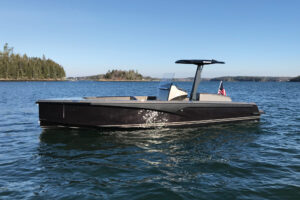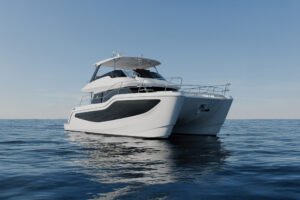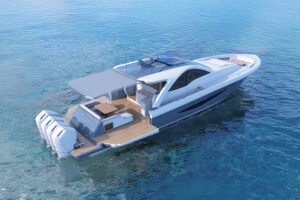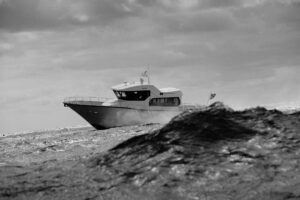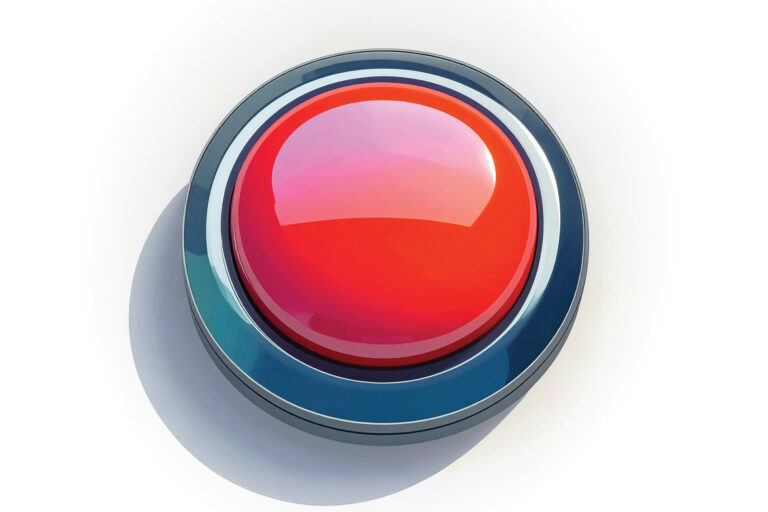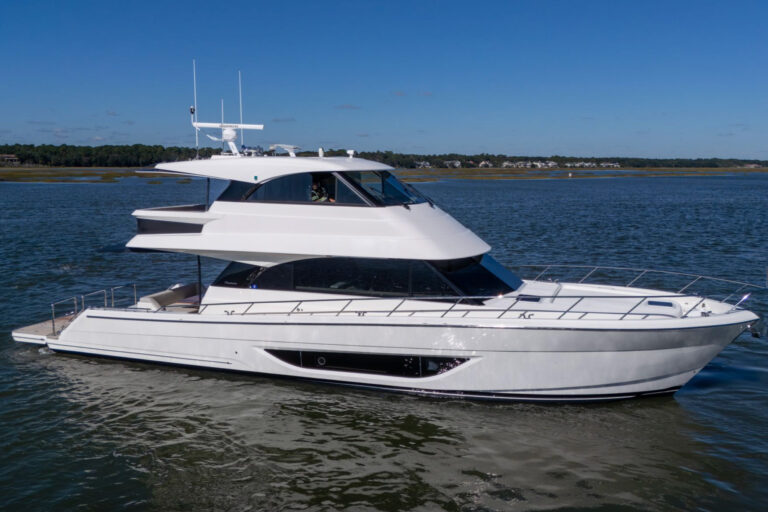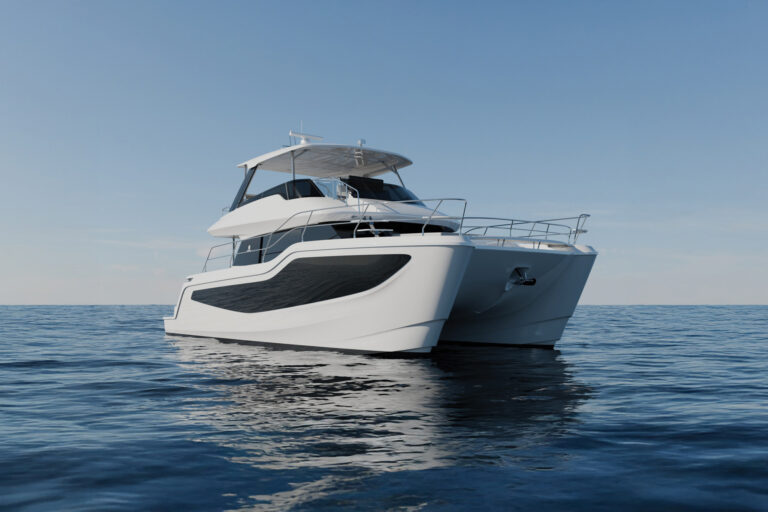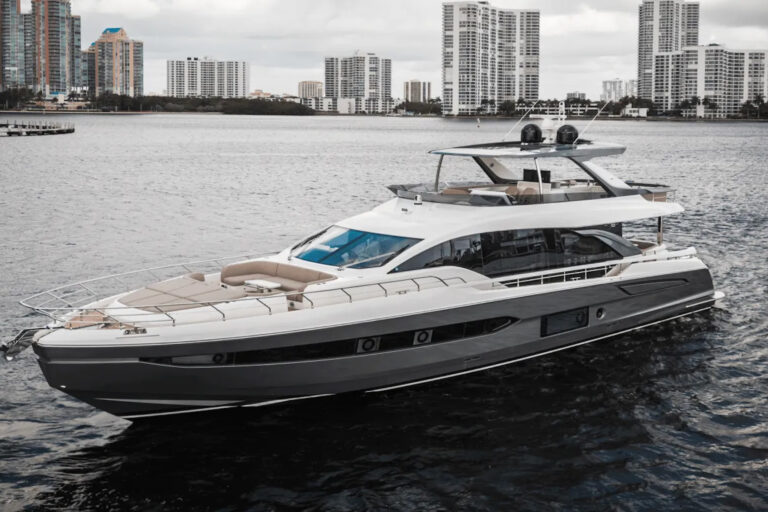Tiara Yachts spent the past year hatching more than a few new models and making subtle changes to existing products. This is interesting, considering how the builder has managed its evolution with conservative precision. If the new 4400 I tested recently reflects the spirit of the cause, it’s clear the folks in Tiara’s design department are inspired.
I have tested a fair number of Tiara products during the past 15 years, and the 4400 is one of the best-running boats from the builder that I have laid hands on. Our sea trial in 2- to 4-foot seas off Ft. Lauderdale included just the sort of chop that can create irritation aboard a boat this size at speed. The 4400 had the strong, punch-through-anything feel Tiara is known for, yet her designers created this effect with far less fuss than in previous models.
“We reduced the beam a bit to create a more easily driven hull at higher speeds”, said John Garland, vice president of design. At 2200 rpm, the 4400 was dry. According to Tiara’s numbers, she trimmed at about 5 degrees without tabs, which I think is ideal. Even tabbing her bow down a bit to engage head seas did not generate spray. “We have spent a good deal of time experimenting with lifting/spray rail design and optimizing balance and trim”, Garland said.
The boat’s slightly convex 38-degree forward sections are designed to deal with the chop, while her moderate after sections (17 degrees) generate lift. Shallow pockets account for propeller tip clearance, and rudder and strut palms are flush with the bottom. While none of this is rocket science, the 4400 is an example of properly balancing these attributes.
Our test boat, fitted with 700 hp Caterpillar C-12s, yielded a maximum speed of 32.8 knots at 2310 rpm. At 2100 rpm, I recorded 29.8 knots and the Caterpillar electronics indicated a fuel burn of 54 gallons per hour. She loafs along quite comfortably at 24.5 knots (1800 rpm) with a fuel burn of 42 gallons per hour. She rises from full stop to full speed in 45 seconds. This time can be trimmed if desired, as the Caterpillar electronics were dialed in for minimum smoke (there was none). For an express-style boat, her sound levels are quite reasonable. At 2100 rpm, I recorded 84 decibels at the helm and 85 decibels in the saloon.
The 4400 is also offered with 535 hp Cummins QSM11s, which Garland expects to trim speed by couple of knots. Either package is a good choice; owners should consider the quality of service in home waters.
The view from the 4400’s helm is excellent, thanks to an impressive Stidd bench seat that can be raised or lowered electrically. The windshield is fitted with wipers and freshwater washers. While Tiara flirted with an angled wheel mount on the 5000, the 4400 is fitted with a traditional stainless-steel destroyer-style (vertical mount) wheel. Though fishermen and sport yacht enthusiasts might object, this setup is perfectly acceptable on a cruising boat. The helm console has enough space for at least two large displays and can be tilted back for access to wiring.
Nestled neatly between the 4000 Express and the 5200 Express in the Tiara line, the 4400 shares styling cues with her larger, more current sister. These include molded-in hull-side air vents and a fiberglass-framed windscreen-a major improvement over the corrosive, painted aluminum of the past.
“We wanted our new express designs to be a bit more artistic, less angular and rigid”, Garland said. The 4400 is just that, and while she is clearly one of the fold, the days of designing with a straight edge are over at Tiara.
The most significant feature of the 4400 is her arch/hardtop. It is standard, and there are no options, according to Garland. “We offered a soft top option on the 5200 and no one wanted it”, he said. Having spent time aboard the 4400, I can understand why. Two 24-inch hatches, an opening windshield section and 16,000 BTUs of air conditioning keep things cool. When closed off with the removable polycarbonate glazing, the area becomes what is essentially an enclosed pilothouse. This is rare on an express boat, and the all-weather environment can make a bad day at sea better. On a steamy summer evening, the lounge area on the bridge can be merged with the cabin for comfortable entertaining.
The cockpit area includes forward- and aft-facing bench seats, and a wet bar with refrigerator (or ice maker). With a push of a button, a section of the cockpit sole rises to form a table. Steps lead aft to the swim/PWC platform, which has a clever launching system that tips a section of the platform instead of relying on a crane or lift. Tiara thoughtfully designed the transom stowage area so it can be accessed with the PWC on the platform.
Two hatches allow access to the machinery space. It is tight, and while there is slim chance of getting outboard of the engines, Tiara made an effort to make all service points accessible. Should the unthinkable happen, the bridge sole can be removed for complete access. I was pleased to find the main electrical panel in the main cabin instead of in the machinery space, an inconvenient location chosen on some Tiara models in the past.
Tiara has also invested in upgrading its interiors. The 4400’s main cabin, owner’s cabin and guest cabin are wrapped in satin-finished teak that seems to be a notch above the builder’s previously high standards. I had expected the teak-and-holly sole (it’s a Tiara trademark), however, I was pleased to also find built-in flat-panel entertainment systems instead of screwed down add-ons, and a fully framed door leading into the owner’s cabin. Domestic refrigeration is fitted instead of smaller dual-voltage marine units. In all, the 4400 is finished and outfitted on par with Tiara’s larger offerings.
The 4400 is built at the company’s Swansboro, North Carolina, facility alongside the 5000 and 5200 models. The site has been at the forefront of the company’s push to modernize its construction techniques.
“We felt the time had come to address environmental issues related to the construction process, and at the same time improve the performance and durability of our products”, Garland said.
The 4400 is the smallest boat in Tiara’s lineup built to the new specifications. Her laminate is composed of stitched multidirectional fiberglass reinforcements and epoxy resin. Epoxy resin is stronger and less porous than polyester resin. End-grain balsa coring in the hull is vacuum-bagged in place to ensure a proper bond. Bulkheads are cored with high-density foam, and the stringer and web frame system is molded in fiberglass and installed into the hull. Fiberglass fuel tanks are a major improvement over the aluminum tanks used in the past.
“The net result is that our new construction method is more costly”, Garland said, “but customers get a better boat.”
It’s a given that the 4400 will please Tiara’s fervent flock of loyal customers, however, I am willing to bet that her quality, features and new, more fluid styling will earn the attention of buyers who may have thought the builder a bit too conservative in the past.
Contact: Tiara Yachts, (616) 392-7163; www.tiarayachts.com.

